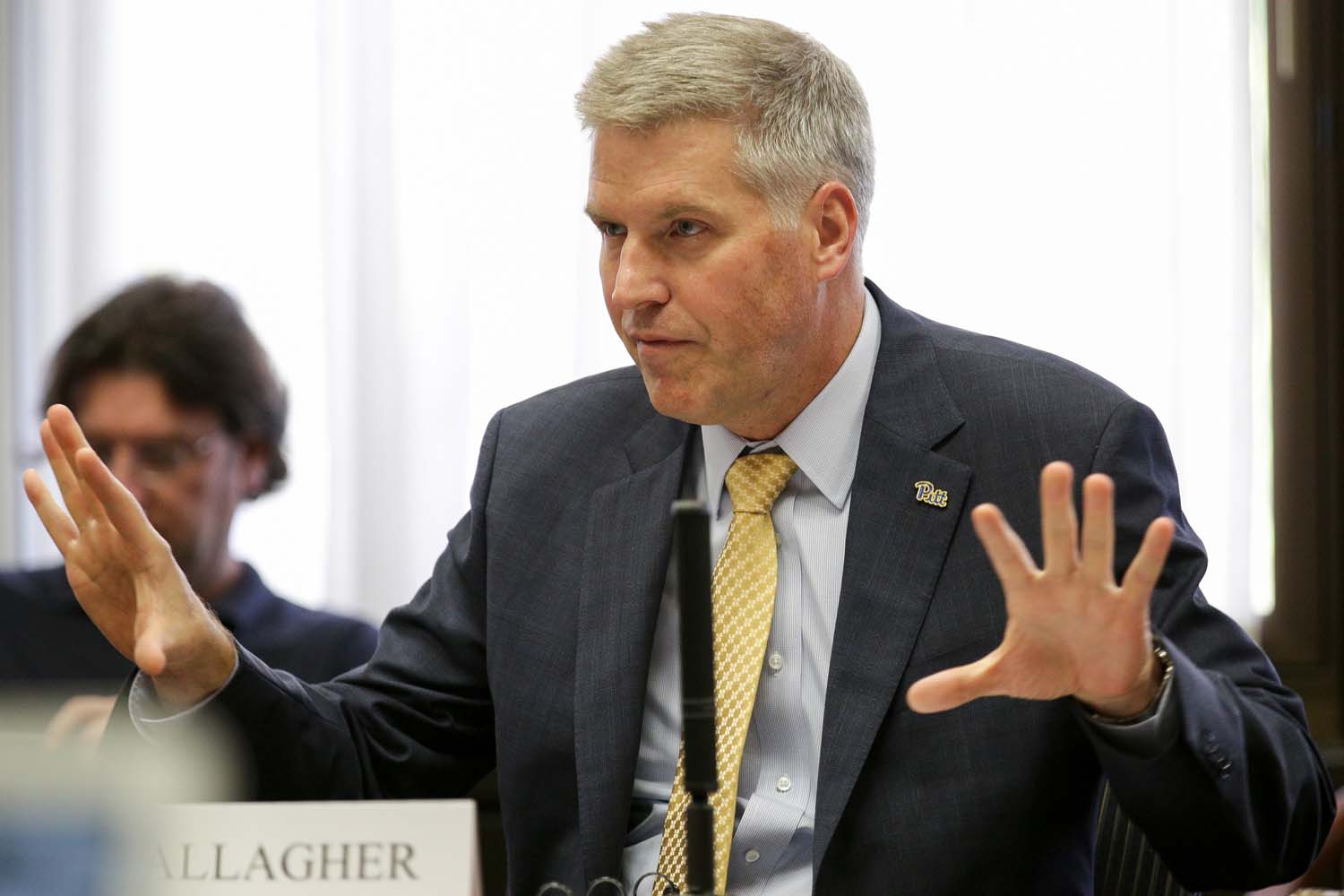Pitt establishes reopening postures for the fall, amidst pandemic


Chancellor Patrick Gallagher at a Senate Council meeting.
Chancellor Patrick Gallagher announced in a Tuesday afternoon email that Pitt has established three reopening postures and universal health rules to guide the University through the ongoing COVID-19 pandemic, as it prepares to welcome students back to campus in just over six weeks.
The three postures, which closely mirror Pennsylvania’s red-yellow-green reopening phases, provide common operating standards to plan for safe operations during the pandemic. Pitt’s Emergency Operations Center, in collaboration with the chancellor’s Healthcare Advisory Group, will monitor different criteria and recommend whether the University should switch between postures.
The three postures include Guarded Risk, Elevated Risk and High Risk:
- In the Guarded Risk posture, which meets the minimum standards of Pennsylvania’s green phase, fewer restrictions are in place, but many mitigation measures remain. The activities taking place will account for chronic risk of operating during a pandemic, while continuing to prioritize health and safety
- In the Elevated Risk Posture, which meets the minimum standards of Pennsylvania’s yellow phase, activities that can be held with the least amount of risk possible are prioritized
- In the High Risk Posture, which meets the minimum standards of Pennsylvania’s red phase, the University is open, but activity is heavily restricted to stop the spread of the virus
Gallagher said that on July 13 the Oakland campus will move to the yellow Elevated Risk posture, and the branch campuses will move to the green Guarded Risk posture.
[Read: Pitt’s COVID-19 response, explained]
Pitt announced earlier this month that it plans to adopt Flex@Pitt, a new teaching model, to allow students to return to campus for the fall semester and experience classes “in person, remotely, synchronously or asynchronously.” The semester will begin early on Aug. 19 with three days of remote classes, moving in-person “where appropriate” on Aug. 24, before students are sent home for the year on Nov. 20 before Thanksgiving.
The health rules, created by the HCAG, will govern behavior on campus to help prevent the spread of the pandemic. These restrictions include a requirement to wear a face covering on campus and inside facilities, maintain physical distance of at least 6 feet, hold gatherings remotely wherever possible and limit time in small spaces such as elevators and bathrooms.
Faculty and staff are also asked to work remotely for the duration of the pandemic whenever possible, Gallagher said, except when their presence on campus is “needed to support students, research and other operations.” For those who must work on campus, staggered shifts and other scheduling strategies will be used to help limit the number of people on campus at any one time.
Provost Ann Cudd said last week that faculty are not required to be physically present in the classroom as part of Flex@Pitt, but are encouraged to, and that an in-person classroom experience must be made available for students.
The University is also taking other steps to help prevent the spread of the virus on campus. It will lease around $22 million in rooms across multiple hotels to house a “significant portion” of first-year students, in an effort to de-densify residence halls. Pitt is also working to de-densify classes, by either holding class remotely, changing rooms or limiting the number of students who can attend lectures at a given time.
Gallagher added that planning updates would be sent on a weekly basis going forward. He said information will be provided on the following timeline:
- Early July: Additional information on housing, vulnerable populations, alternative enrollment options for international students and international travel safety guidance for students, faculty and staff
- Mid-July: More technology and space details for Flex@Pitt, scheduling and academic support, extracurricular activities and non-academic support, as well as principles for meetings, events and travel
- Late July: Virus testing, symptom monitoring, quarantining and contact tracing protocols
Gallagher said the goal of the fall semester planning is to maximize the University’s mission while keeping community members safe.
“It will help us stay flexible so that Pitt is still Pitt — regardless of what course this virus takes,” Gallagher said.
Recent Posts
Opinion | School should be in the summer
Although this may be controversial, I believe that from this data, it is evident that…
Weathering the storm: Pittsburgh teams have tackled some of the toughest environments
The end of the year in western Pennsylvania is always marked by two things —…
Notes From an Average Girl // Notes on Book Banning
In this edition of Notes From an Average Girl, senior staff writer Madeline Milchman writes…
To Be Honest // Yup, it is that damn phone
In this edition of To Be Honest, staff writer Evin Verbrugge writes about her phone…
Meaning at the Movies | Portraying Toxic ‘Adolescence’
In this edition of Meaning at the Movies, staff writer Lauren Deaton explores the mini-series…
Opinion | Climate change requires radical, immediate action
Contributing editor Emma Hannan talks about the effects of climate change and the actions cities…

